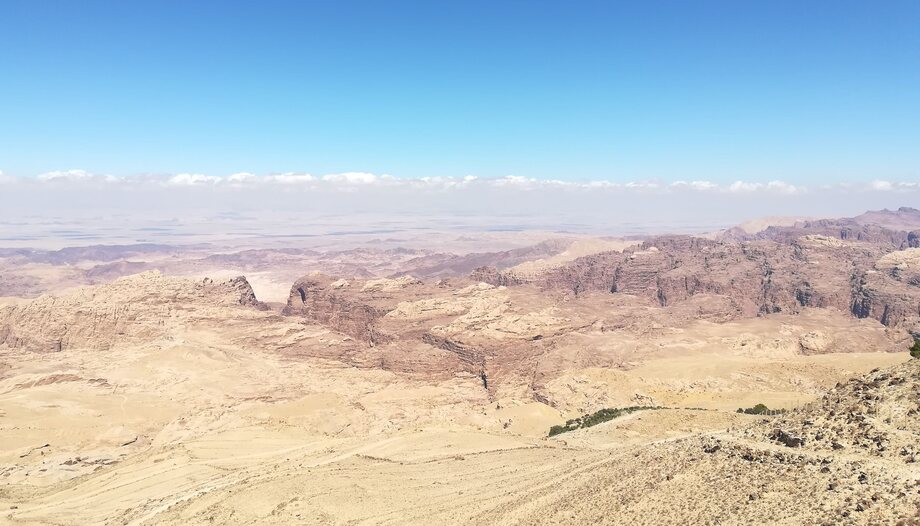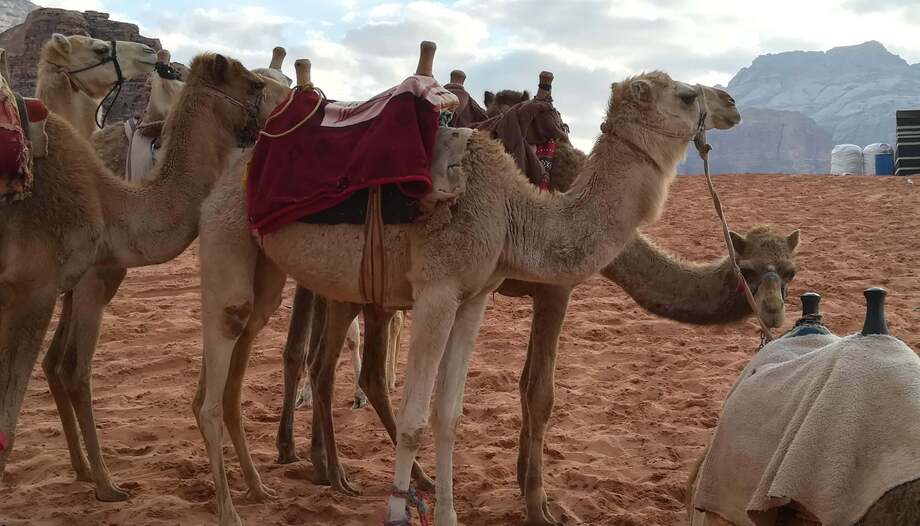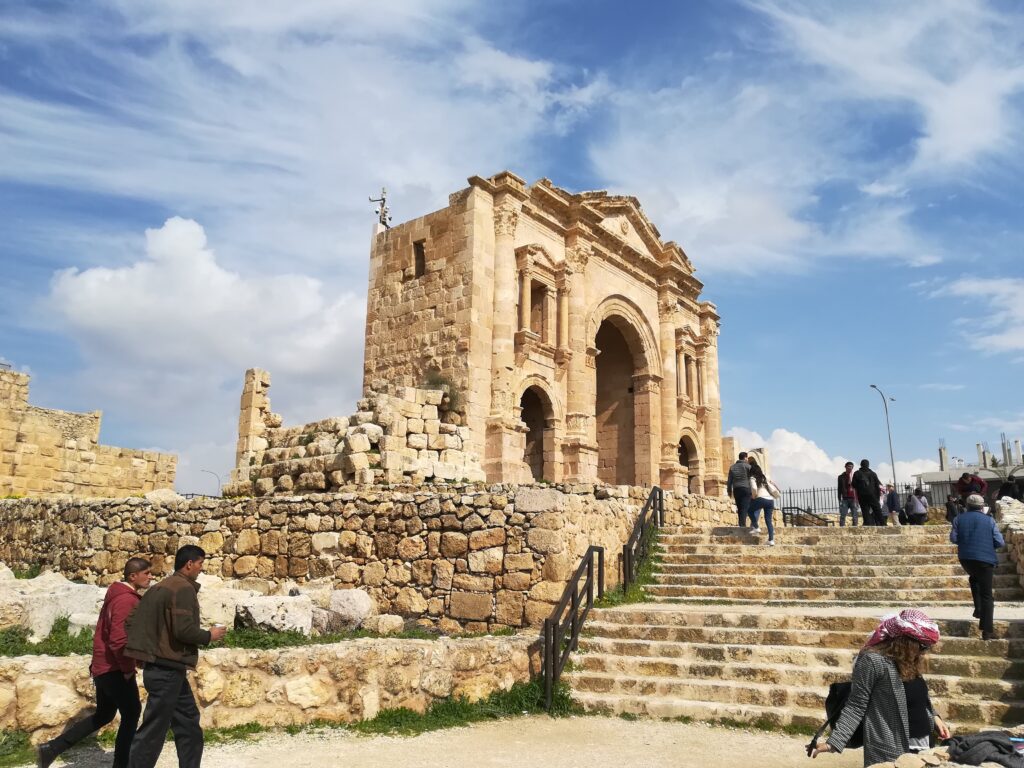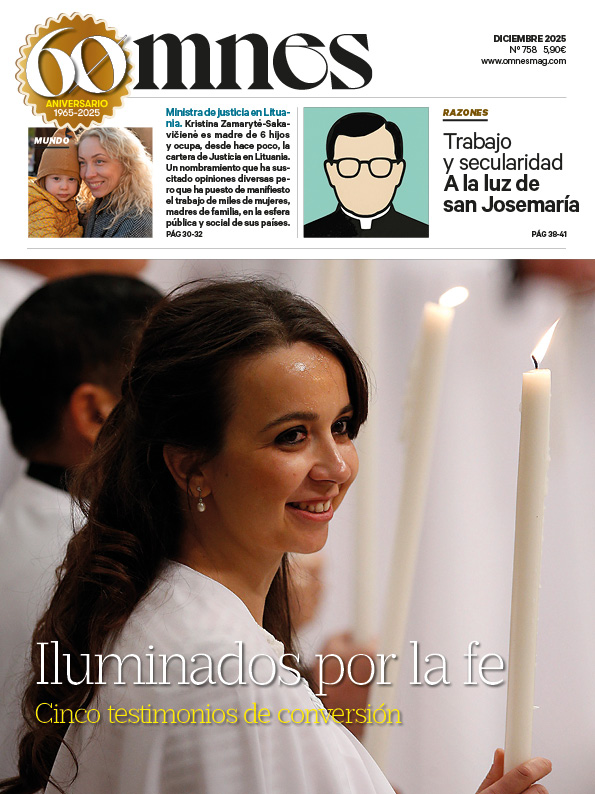Imagine a desert, that of Wadi Rum, of ochre, amber, saffron and orange colors, whose shades vary according to the season, the weather, the sun's rays and which are especially illuminated at sunset.
Imagine also a short stretch of coastline on the Red Sea, where the water-green sea, under the turquoise blue of the sky, kisses with its waves a rugged and desolate land, jagged and full of bare rock mountains, from which the beaches of Israel, Egypt and Saudi Arabia can be seen.
Imagine more, the marble columns of ancient Jerash, the salt-white shores of the Dead Sea, the monumental beauty of Petra, set like a pearl in the desert. And the slow flow of the Jordan dividing countries, worlds, cultures and communities struggling to find harmony.
Mountains, borders, languages, cultures, deserts and hills: this is Jordan, a treasure chest in the desert.
The origin of the name
Jordan, officially the Hashemite Kingdom of Jordan, is a Middle Eastern country. It is bordered to the north by Syria, to the northeast by Iraq, to the east and south by Saudi Arabia, to the southwest by the Red Sea and to the west by Israel and the West Bank. Its capital is Amman, which, with more than 4 million inhabitants, is also its largest city and economic and cultural center.
The name "Jordan" derives precisely from the Jordan River, specifically from the Hebrew term used to designate this river: Yarden(from ירד, yarad, which means "to descend" and reflects the slope of the river from its source on Mount Hermon to the Dead Sea, the lowest point on earth, at -430 meters above sea level). However, the area corresponding to present-day Jordan was historically known (also in the Bible) as Transjordan, i.e. "beyond the Jordan", "the other side of the Jordan", to indicate the lands located east of the river.
Political system and population
The country's surface area is 89,342 km² (approximately the same as Portugal) and the population is around 11.5 million inhabitants.
Jordan is a constitutional monarchy, with the king endowed with broad executive and legislative powers. The current monarch is King Abdullah II, son of the famous Hussein and one of his wives, in power since 1999. The kingdom is called Hashemite after the dynasty of the royal family, which claims direct descent from Muhammad.
The majority of the Jordanian population is composed of Arabs, with those of Palestinian origin reaching 60 % - 70 % (Queen Rania belongs to this group). On the other hand, between 30 % and 40 % are of Bedouin origin. There are also small communities of Circassians, Chechens and Armenians.
Sunni Islam is the religion of about 97 % of the population, while Christians represent between 2 % and 3 % (mostly Greek Orthodox belonging to the Patriarchate of Jerusalem, but also Catholics and Protestants). Druze and Baha'i represent small minorities. However, the country is known for religious tolerance and peaceful coexistence between the different religious communities.
Economy of Jordan
Jordan has one of the most diversified economies in the Middle East, with key sectors such as tourism, the phosphate industry, textiles and pharmaceuticals, and financial services, although it is highly dependent on foreign aid, particularly from the United States and the Gulf countries.
It is also of strategic importance, both for its political stability and the moderate stance of its regime, an important player in the maintenance of peace and security in the region.

Ancient history: from the Ammonites to the Nabataeans
Jordan's ancient history is very rich, due to the many civilizations and cultures that have succeeded one another over the millennia, the region being a crossroads between Asia, Africa and Europe.
Although the earliest evidence of human settlement in the region dates back to the Paleolithic (around 200,000 years ago), it was during the Neolithic (around 8500-4500 BC) that some of the world's first agricultural communities developed here. In the Bronze Age (around 3300-1200 BC), the trade routes linking the eastern Mediterranean with Mesopotamia flourished, and several city-states and small kingdoms flourished there, including one associated with the biblical Sodom (on the Israeli side of the Jordan River).
However, it was in the Iron Age (ca. 1200-539 B.C.) that the famous kingdoms and peoples also mentioned in the Bible emerged, mainly the Ammonites (who lived in the area of Amman, a city named after its capital Rabbath Ammon).
They were a Semitic people who often came into conflict with the Israelites (as well as with other neighboring powers) not only for economic and territorial reasons, but also for religious ones. In fact, the Ammonites, like other Semitic peoples of the region, were polytheistic, "pagan", and paid human sacrifices to their main deity, Milkom, also known as Moloch.
Another people who have become famous, especially because of the account of them in the Hebrew and Christian Scriptures, are the Moabites. The beautiful "Book of Ruth"tells the story of a Moabite woman, Ruth, widow of an Israelite, who is forced by a famine to return with her mother-in-law Noemi to the birthplace of her late husband's family, Bethlehem of Judea. There, after several hardships, she becomes the wife of Boaz, her husband's closest relative, and bears him a son, Obed, who will be the father of Jesse, in turn the father of King David.
The Moabites, like the Ammonites and other peoples of the area, were also disliked by the Israelites for their religious practices. They lived in the area immediately east of the Dead Sea and their main city was Qir-Moab (today al-Karak).
The Edomites (from (Edom), on the other hand, were located in the southern part of present-day Jordan. They had Bosra as their capital (but they also founded Petra) and controlled the main trade routes from the Mediterranean to Arabia.
All these peoples spoke northwestern Semitic languages (such as Hebrew, Phoenician and Aramaic). In fact, their languages constituted a dialectal continuum (Phoenician-Punic and Canaanite-Hebrew), so that, apart from not too significant differences, Hebrews, Moabites, Phoenicians, Edomites and Ammonites could understand each other.
Between 539 (conquest of Cyrus the Great) and 332 BC, the region became part of the Persian Empire, then fell under Hellenistic influence and was disputed between 332 and 63 BC between the Ptolemies of Egypt and the Seleucids of Syria, dynasties that divided the domains subjugated by Alexander the Great.
From this period dates the development of a group of ten cities known as the Decapolis. These were politically completely autonomous from each other, but were grouped under one name because of their strong linguistic and cultural affinities, being Greco-Roman (or mixed) and pagan centers in a mainly Semitic area. It included cities such as Damascus, Amman (at that time no longer known as Rabbath Ammon, but as Philistia), Jerash (Jerash), Scythopolis (today Beth-Shean, in Israel, the only city west of the Jordan River), Hippos (Hippus or Sussita), Gadara (Umm Qays). All these cities, except Scythopolis (in Israel) and Damascus (in Syria), were located in the territory of present-day Jordan and, in Roman times (63 BC-324 AD), although annexed to the Empire, continued to enjoy great autonomy and wealth.

Jordan in the Gospels
The Gospels speak much of the territory of the Gadarenes or Gerasenes (in the Decapolis, in fact) and particularly famous is the episode of the miracle performed by Jesus on the other side of the Sea of Galilee in favor of a possessed man, whose release led the spirits that possessed him to a herd of pigs that then jumped into the water from a cliff.
Interesting, in this episode, from a historical point of view, is, first of all, the presence of pigs, which were (and are) considered impure in Israel, but which could be bred, instead, in this pagan area. In addition, topographical indications also made it possible to place the event on the eastern shore of Lake Tiberias, in a settlement known in antiquity as Kursi (city of the territory of the Decapolis), near Hippos-Sussita, due to the cliff of a promontory that rose above the water.
The remains of a Byzantine monastery built in the 6th century on the site of the miracle were also found here and can be visited today. Another place of special value, from the Judeo-Christian point of view, is Mount Nebo, in western Jordan, very close to the border with Israel and the West Bank, where there is a Catholic monastery from which one can contemplate, as Moses traditionally did, the Dead Sea, the Jordan Valley, with the city of Jericho, and the mountains of Judea as far as Jerusalem.
From Hippo, which became a flourishing Christian center shortly after the death of Jesus, it is said that the entire Christian community of Jerusalem, which took refuge here during the years of the destruction of the city and the Temple by the Romans, then spread throughout Transjordan.
The Nabataeans
Another important indigenous population and kingdom were the Nabataeans (the period of the Nabataean kingdom spans from around the 4th century BC to 106 AD, when it was annexed by Trajan, who made it the province of Arabia Petrea).
Unlike other peoples, such as the Moabites or the Ammonites, the Nabataeans already spoke a form of Aramaic (a lingua franca of the time, so it was not a Canaanite language, like Hebrew, Phoenician, Moabite, etc., although related to them) and had developed a variant of the Aramaic alphabet which, according to some scholars, later gave rise to the Arabic alphabet still in use today.
The jewel in the crown of the Nabataeans, already known for their trading skills, was their capital, Petra, world famous for its rock-cut architecture, which became an important center along the caravan route linking Arabia to the Mediterranean. The city, founded by the Edomites (forerunners of the Nabataeans) under the name of Reqem or Raqmu ("the Motley"), after a period of great splendor that lasted well into the Roman and Byzantine eras, was not abandoned until the 8th century AD.C. and, with the exception of a few local Bedouin families, remained unknown to the rest of the world until 1812, when the Swiss explorer Johann Ludwig Burckhardt "rediscovered" it during one of his voyages.
With the division of the Roman Empire, Jordan became part of the Eastern (Byzantine) Empire, a period that saw, until the Islamic conquest, a growing influence of Christianity, with the construction of numerous churches and monasteries. Among the most important Byzantine sites in Jordan is Madaba, known for its mosaics, including the Madaba map, a detailed representation of the Holy Land.








